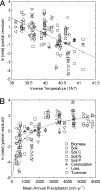Amplified temperature dependence in ecosystems developing on the lava flows of Mauna Loa, Hawai'i
- PMID: 18156366
- PMCID: PMC2224191
- DOI: 10.1073/pnas.0710214104
Amplified temperature dependence in ecosystems developing on the lava flows of Mauna Loa, Hawai'i
Abstract
Through its effect on individual metabolism, temperature drives biologically controlled fluxes and transformations of energy and materials in ecological systems. Because primary succession involves feedbacks among multiple biological and abiotic processes, we expected it to exhibit complex dynamics and unusual temperature dependence. We present a model based on first principles of chemical kinetics to explain how biologically mediated temperature dependence of "reactant" concentrations can inflate the effective temperature dependence of such processes. We then apply this model to test the hypothesis that the temperature dependence of early primary succession is amplified due to more rapid accumulation of reactants at higher temperatures. Using previously published data from the lava flows of Mauna Loa, HI, we show that rates of vegetation and soil accumulation as well as rates of community compositional change all display amplified temperature dependence (Q(10) values of approximately 7-50, compared with typical Q(10) values of 1.5-3 for the constituent biological processes). Additionally, in young ecosystems, resource concentrations increase with temperature, resulting in inflated temperature responses of biogeochemical fluxes. Mauna Loa's developing ecosystems exemplify how temperature-driven, biologically mediated gradients in resource availability can alter the effective temperature dependence of ecological processes. This mechanistic theory should contribute to understanding the complex effects of temperature on the structure and dynamics of ecological systems in a world where regional and global temperatures are changing rapidly.
Conflict of interest statement
The authors declare no conflict of interest.
Figures




References
-
- Brown JH, Gillooly JF, Allen AP, Savage VM, West GB. Ecology. 2004;85:1771–1789.
-
- Allen AP, Gillooly JF, Brown JH. Funct Ecol. 2005;19:202–213.
-
- Anderson KJ, Allen AP, Gillooly JF, Brown JH. Ecol Lett. 2006;9:673–682. - PubMed
-
- Walker LR, del Moral R. Primary Succession and Ecosystem Rehabilitation. Cambridge, UK: Cambridge Univ Press; 2003.
-
- Vitousek P. Nutrient Cycling and Limitation: Hawai'i as a Model System. Princeton: Princeton Univ Press; 2004.
Publication types
MeSH terms
Substances
LinkOut - more resources
Full Text Sources

